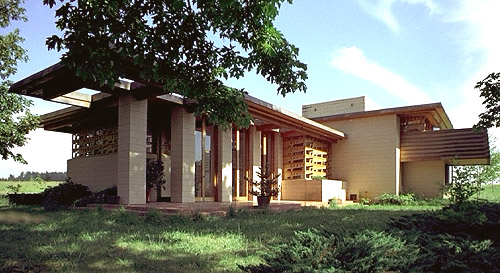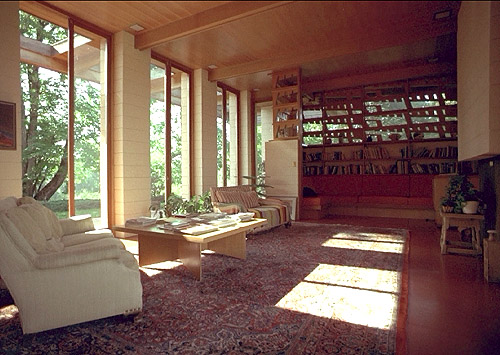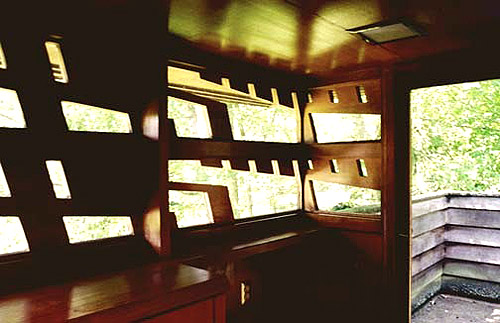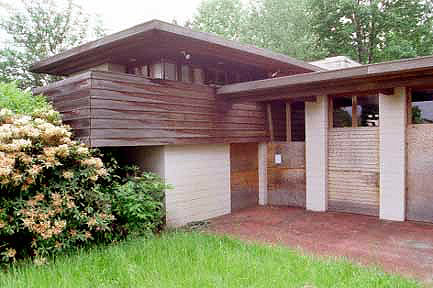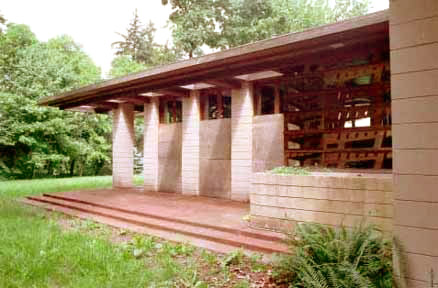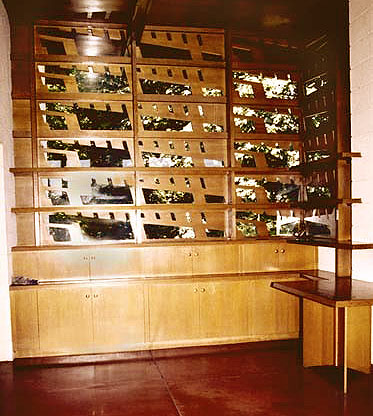Conrad and Evelyn Gordon Residence, Wilsonville, Oregon (1956) (S.419)
(Note, due to the fact that the internet is constantly changing, and items that
are posted change, I have copied the text, but give all the credits available.)
Agreement saves Wright's Gordon Residence from Demolition
House to be moved by Frank Lloyd Wright Building Conservancy
by Richard Hovey
http://www.jetsetmodern.com/flwgordon.htmOREGON CITY, Ore.- During a crowded meeting here on November 30, Clackamas County Commissioners voted to remove architect Frank Lloyd Wright's 1957 Gordon Residence in Wilsonville from its Historic Resources list. Commissioners took great care to point out that they had no discretion in the matter under state law. They hastened to add that their action would help save the structure from demolition because the new property owners have agreed to donate the house to the Chicago-based Frank Lloyd Wright Building Conservancy which will move it to another site.
Viewed from the North West Photo by William Allin Storrer
The house is the only building in the state of Oregon designed by Wright, the noted architect who died in 1959. Holding up an inch-thick stack of letters and email from all over the country, Commissioner Mike Jordan said, "I've never had so much mail on one issue in my 16 years of public service."
Conservancy board member, Deborah Vick, a Seattle area resident who lives in a Wright-designed home, attended the meeting representing the organization. "Since the Conservancy was founded in 1989, not one of the approximately 350 remaining Wright buildings has been destroyed." Vick said, speaking to a crowd of reporters, local architects, historical society members and concerned Wright fans. "We are pleased that we have been able to help prevent that from happening here in your backyard."
Living Room Photo by William Allin Storrer
In Chicago, Carol Wyant, Acting Executive Director of the Conservancy explained that the organization would oversee the moving and restoration of the home. "We are interested in talking with any serious buyers who have the resources to become the new owners of the house." She said.
In attendance at the hearing today were San Francisco Bay area residents, Jay and Diane Plessent, who had tried to purchase the property when it was first placed on the market in 1998. They have already begun searching for a parcel of land in Clackamas County for the home. They intend to move to the Portland area and hope to become the eventual owners and residents of the house.
Upstairs Bedroom Photo by Richard Hovey
David A. and Carey L. Smith of Wilsonville are the current owners of the 22-acre property. They purchased it in September with the intention of building a new home on it. Located on the south bank of the Willamette River near the up-scale Charboneau development, the land offers a clear view of Mt. Hood. Except for the site of the existing Wright structure, the entire property lies outside the Urban Growth Boundary. Oregon law prevents building outside that boundary. Unable to build anywhere else on the land, this prompted the Smiths to seek a demolition permit for the house.
Viewed from the North East. Doors boarded up during vacancy before rescue and relocation. Photo by Richard Hovey
The Smiths bought the property for $1.1 million after it had languished on the market for over two years at the $2.4-$2.75 million price asked by Edward Gordon. His parents, Conrad and Evelyn Gordon commissioned the 2,200 sq. ft. "Usonian" house, during 1957 and built it in the 1960s. Constructed of concrete block on a thin, concrete slab, it was originally designed in 1938 and featured in Life magazine as a prototype, affordable home for the middle class. There is one other house in the country based on this design. Living Room on the left, Dining Room is on the right. Doors boarded up during vacancy before rescue and relocation. Photo by Richard Hovey
Moving the two-story, "T" shaped, concrete structure will not be easy. It would most likely be dismantled to some extent. Another Usonian block design, Wright's 1939, Pope-Leighey House at The National Trust's Woodlawn Plantation in Alexandria, Virginia, was successfully moved twice. In 1964, the 1,600 sq.-ft., "L"-shaped house was moved about 16 miles to Woodlawn Plantation. It was broken into modules and reassembled on a new slab with some new masonry. Due to poor soil conditions at the site, the house had to be moved again a short distance in 1995.
Dining Room with built-ins. Photo by Richard Hovey
In addition to the involvement of the Frank Lloyd Wright Building Conservancy, The Portland Office of the American Institute of Architects led by Executive Director Saundra Stevens took an active role in helping to save the home. Both she and Architect Robert Dortignacq, AIA, Chair of the chapter's Historic Resources Committee, were on hand at the Commissioners' meeting. Afterwards, Dortignacq, sketched out details of how the house could be moved for the print and TV reporters.
Richard Hovey is an architectural photographer, educator and writer. He publishes a bi-monthly printed newsletter called "The Artistic Traveler". For more info, see his website at: www.artistictraveler.com.
BACK HOME ARTIFACTS AUDIO BOOKS PERIODICALS PHOTOS POSTCARDS POSTERS STAMPS STUDIES ASSISTING ABOUT SEARCH
©Copyright 2008
